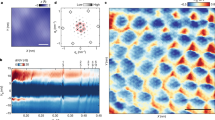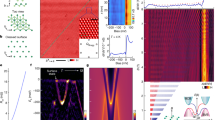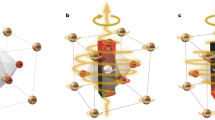Abstract
Vortices in topological superconductors may host Majorana zero modes (MZMs), which have been proposed as the building blocks of fault-tolerant topological quantum computers. Recently, a new single-material platform with the potential for realizing MZMs has been discovered in iron-based superconductors, without involving hybrid semiconductor–superconductor structures. Here, we report a detailed scanning tunnelling spectroscopy study of a FeTe0.55Se0.45 single crystal and show that this material hosts two distinct classes of vortex. These differ by a half-integer level shift in the energy spectra of the vortex bound states. This level shift is directly tied to the presence or absence of a zero-bias conductance peak and also alters the ratios of higher energy levels from integer to half-odd-integer. Our model calculations fully reproduce the spectra of these two types of vortex bound state, suggesting the presence of regions with and without topological surface states, which coexist within the same crystal. Our findings provide strong evidence for the presence of MZMs in FeTe0.55Se0.45 and establish it as an excellent platform for further studies.
This is a preview of subscription content, access via your institution
Access options
Access Nature and 54 other Nature Portfolio journals
Get Nature+, our best-value online-access subscription
$29.99 / 30 days
cancel any time
Subscribe to this journal
Receive 12 print issues and online access
$209.00 per year
only $17.42 per issue
Buy this article
- Purchase on Springer Link
- Instant access to full article PDF
Prices may be subject to local taxes which are calculated during checkout





Similar content being viewed by others
Data availability
The data that support the findings of this study are available from the corresponding authors on reasonable request.
Change history
13 March 2020
An amendment to this paper has been published and can be accessed via a link at the top of the paper.
References
Nayak, C. et al. Non-Abelian anyons and topological quantum computation. Rev. Mod. Phys. 80, 1083–1159 (2008).
Read, N. et al. Paired states of fermions in two dimensions with breaking of parity and time-reversal symmetries and the fractional quantum Hall effect. Phys. Rev. B 61, 10267–10297 (2000).
Kitaev, A. Y. Unpaired Majorana fermions in quantum wires. Phys. Uspekhi 44, 131–136 (2001).
Fu, L. & Kane, C. L. Superconducting proximity effect and Majorana fermions at the surface of a topological insulator. Phys. Rev. Lett. 100, 096407 (2008).
Lutchyn, R. M., Sau, J. D. & Sarma, S. D. Majorana fermions and a topological phase transition in semiconductor–superconductor heterostructures. Phys. Rev. Lett. 105, 077001 (2010).
Oreg, Y., Refael, G. & von Oppen, F. Helical liquids and Majorana bound states in quantum wires. Phys. Rev. Lett. 105, 177002 (2010).
Mourik, V. et al. Signatures of Majorana fermions in hybrid superconductor–semiconductor nanowire devices. Science 336, 1003–1007 (2012).
Nadj-Perge, S. et al. Observation of Majorana fermions in ferromagnetic atomic chains on a superconductor. Science 346, 602–607 (2014).
Sun, H. H. et al. Majorana zero mode detected with spin selective Andreev reflection in the vortex of a topological superconductor. Phys. Rev. Lett. 116, 257003 (2016).
Deng, M. T. et al. Majorana bound state in a coupled quantum-dot hybrid-nanowire system. Science 354, 1557–1562 (2016).
Jeon, S. et al. Distinguishing a Majorana zero mode using spin-resolved measurements. Science 358, 772–776 (2017).
Zhang, H. et al. Quantized Majorana conductance. Nature 556, 74–79 (2018).
Wang, Z.-J. et al. Topological nature of the FeSe0.5Te0.5 superconductor. Phys. Rev. B 92, 115119 (2015).
Wu, X.-X. et al. Topological characters in Fe(Te1 − xSex) thin films. Phys. Rev. B 93, 115129 (2016).
Xu, G. et al. Topological superconductivity on the surface of Fe-based superconductors. Phys. Rev. Lett. 117, 047001 (2016).
Zhang, P. et al. Observation of topological superconductivity on the surface of iron-based superconductor. Science 360, 182–186 (2018).
Wang, D. et al. Evidence for Majorana bound states in an iron-based superconductor. Science 362, 333–335 (2018).
Liu, Q. et al. Robust and clean Majorana zero mode in the vortex core of high-temperature superconductor (Li0.84Fe0.16)OHFeSe. Phys. Rev. X 8, 041056 (2018).
Xu, J.-P. et al. Experimental detection of a Majorana mode in the core of a magnetic vortex inside a topological insulator–superconductor Bi2Te3/NbSe2 heterostructure. Phys. Rev. Lett. 114, 017001 (2015).
Rinott, S. et al. Tuning across the BCS–BEC crossover in the multiband superconductor Fe1 + ySexTe1 − x: an angle-resolved photoemission study. Sci. Adv. 3, e1602372 (2017).
Hayashi, N. et al. Low-lying quasiparticle excitations around a vortex core in quantum limit. Phys. Rev. Lett. 80, 2921–2924 (1998).
Caroli, C., de Gennes, P. G. & Matricon, J. Bound Fermion states on a vortex line in a type II superconductor. Phys. Lett. 9, 307–309 (1964).
Gygi, F. & Schluter, M. Self-consistent electronic structure of a vortex line in a type-II superconductor. Phys. Rev. B 43, 7609–7621 (1990).
Alicea, J. New directions in the pursuit of Majorana fermions in solid state systems. Rep. Prog. Phys. 75, 076501 (2012).
He, X.-B. et al. Nanoscale chemical phase separation in FeTe0.55Se0.45 as seen via scanning tunneling spectroscopy. Phys. Rev. B 83, 220502 (2011).
Lin, W.-Z. et al. Direct probe of interplay between local structure and superconductivity in FeTe0.55Se0.45. ACS Nano 7, 2634–2641 (2013).
Singh, U. R. et al. Spatial inhomogeneity of the superconducting gap and order parameter in FeSe0.4Te0.6. Phys. Rev. B 88, 155124 (2013).
Massee, F. et al. Imaging atomic-scale effects of high-energy ion irradiation on superconductivity and vortex pinning in Fe(Se,Te). Sci. Adv. 1, e1500033 (2015).
Suderow, H. et al. Imaging superconducting vortex cores and lattices with a scanning tunneling microscope. Supercond. Sci. Technol. 27, 063001 (2014).
Chen, M. et al. Discrete energy levels of Caroli–de Gennes–Martricon states in quantum limit in FeTe0.55Se0.45. Nat. Commun. 9, 970 (2018).
Yin, Z. P., Haule, K. & Kotliar, G. Spin dynamics and orbital–antiphase pairing symmetry in iron-based superconductors. Nat. Phys. 10, 845–850 (2014).
Khaymovich, I. M. et al. Vortex core states in superconducting graphene. Phys. Rev. B 79, 224506 (2009).
Jackiw, R. & Rossi, P. Zero modes of the vortex–fermion system. Nucl. Phys. B 190, 681–691 (1981).
Ghaemi, P. & Wilczek, F. Near-zero modes in superconducting graphene. Phys. Scr. 146, 014019 (2012).
Colbert, J. & Lee, P. A. Proposal to measure the quasiparticle poisoning time of Majorana bound states. Phys. Rev. B 89, 140505 (2014).
Liu, C.-X., Liu, D. E., Zhang, F.-C. & Chiu, C.-K. Protocol for reading out Majorana qubit and testing non-Abelian statistics. Preprint at https://arxiv.org/abs/1901.06083 (2019).
Shan, L. et al. Observation of ordered vortices with Andreev bound states in Ba0.6K0.4Fe2As2. Nat. Phys. 7, 325–331 (2011).
Hanaguri, T. et al. Scanning tunneling microscopy/spectroscopy of vortices in LiFeAs. Phys. Rev. B 85, 214505 (2012).
Hess, H. F., Robinson, R. B. & Waszczak, J. V. Vortex-core structure observed with a scanning tunneling microscopy. Phys. Rev. Lett. 64, 2711–2714 (1990).
Kaneko, S.-I. et al. Quantum limiting behaviors of a vortex core in an anisotropic gap superconductor. J. Phys. Soc. Jpn 81, 063701 (2012).
Coldea, A. I. & Watson, M. D. The key ingredients of the electronic structure of FeSe. Annu. Rev. Condens. Matter Phys. 9, 125–146 (2018).
Hu, L.-H. et al. Theory of spin-selective Andreev reflection in the vortex core of a topological superconductor. Phys. Rev. B 94, 224501 (2016).
Hasan, M. Z. & Kane, C. L. Colloquium: topological insulators. Rev. Mod. Phys. 82, 3045–3067 (2010).
Schubert, G. et al. Fate of topological-insulator surface states under strong disorder. Phys. Rev. B 85, 201105 (2012).
Sacksteder, V., Ohtsuki, T. & Kobayashi, K. Modification and control of topological insulator surface states using surface disorder. Phys. Rev. Appl. 3, 064006 (2015).
Fu, L., Kane, C. L. & Mele, E. J. Topological insulators in three dimensions. Phys. Rev. Lett. 98, 106803 (2007).
Noguchi, R. et al. A weak topological insulator state in quasi-one-dimensional bismuth iodide. Nature 566, 518–522 (2019).
Qin, S.-S. et al. Topological vortex phase transitions in iron-based superconductors. Preprint at https://arxiv.org/abs/1901.03120 (2019).
Shi, X. et al. FeTe1 - xSex monolayer films: towards the realization of high-temperature connate topological superconductivity. Sci. Bull. 62, 503–507 (2017).
Peng, X.-L. et al. Observation of topological transition in high-T c superconductor FeTe1 - xSex/SrTiO3(001) monolayers. Preprint at https://arxiv.org/abs/1903.05968 (2019).
Acknowledgements
We thank N.F. Yuan, C.-K. Chiu, C. Schrade, S.-S. Qin and R.-X. Zhang for helpful discussions and F.-Z. Yang, G.-J. Qian for technical assistance. The work at IOP is supported by grants from the Ministry of Science and Technology of China (2015CB921000, 2015CB921300 and 2016YFA0202300), the National Natural Science Foundation of China (11234014, 11574371 and 61390501), and the Chinese Academy of Sciences (XDB28000000 and XDB07000000). The work at MIT is supported by DOE Office of Basic Energy Sciences, Division of Materials Sciences and Engineering under award no. DE-SC0019275. G.D.G. is supported by US DOE DE-SC0012704. J.S. and R.D.Z. are supported by the Center for Emergent Superconductivity, an EFRC funded by the US DOE.
Author information
Authors and Affiliations
Contributions
H.D. and H.-J.G. designed the experiments. S.Z., L.C., H.C. and Y.X. performed the STM experiments with assistance from L.K., W.L., D.W., P.F. and S.D. M.P., H.I. and L.F. provided theoretical models and simulations. J.S., R.Z. and G.D.G. provided samples. L.K., S.Z. and H.D. analysed experiment data with input from all other authors. L.K., M.P. and S.Z. plotted figures with input from all other authors. All authors participated in writing the manuscript. H.D., H.-J.G. and L.F. supervised the project.
Corresponding authors
Ethics declarations
Competing interests
The authors declare no competing interests.
Additional information
Peer review information: Nature Physics thanks Peter Wahl and the other, anonymous, reviewer(s) for their contribution to the peer review of this work.
Publisher’s note: Springer Nature remains neutral with regard to jurisdictional claims in published maps and institutional affiliations.
Supplementary information
Supplementary Information
Additional theoretical and experimental details, Supplementary Figs. 1–11 and refs. 1–41.
Rights and permissions
About this article
Cite this article
Kong, L., Zhu, S., Papaj, M. et al. Half-integer level shift of vortex bound states in an iron-based superconductor. Nat. Phys. 15, 1181–1187 (2019). https://doi.org/10.1038/s41567-019-0630-5
Received:
Accepted:
Published:
Issue Date:
DOI: https://doi.org/10.1038/s41567-019-0630-5
This article is cited by
-
Dislocation Majorana bound states in iron-based superconductors
Nature Communications (2024)
-
Topological superconducting vortex from trivial electronic bands
Nature Communications (2023)
-
Composition and phase engineering of metal chalcogenides and phosphorous chalcogenides
Nature Materials (2023)
-
Topological phenomena at defects in acoustic, photonic and solid-state lattices
Nature Reviews Physics (2023)
-
Roadmap of the iron-based superconductor Majorana platform
Science China Physics, Mechanics & Astronomy (2023)



